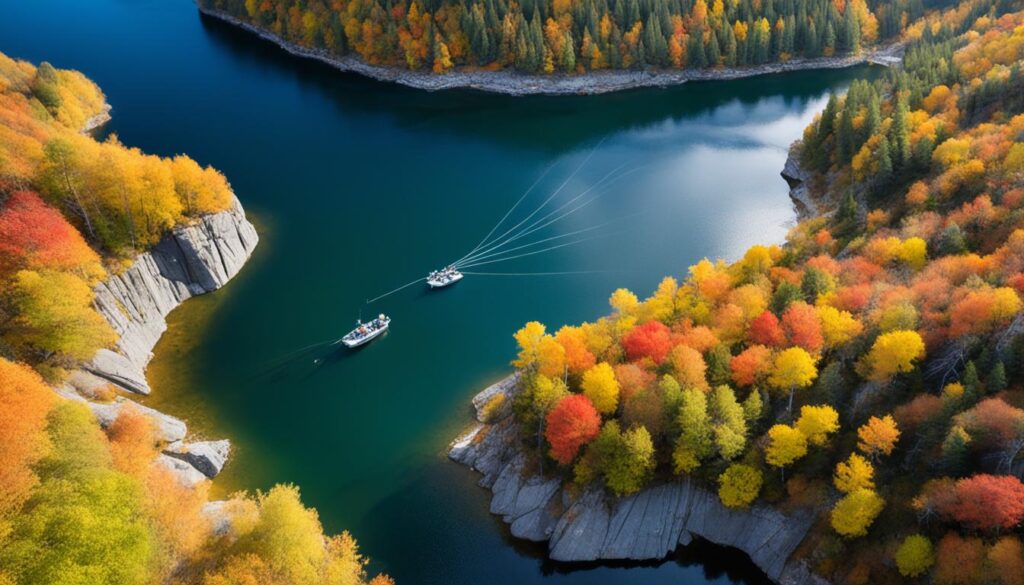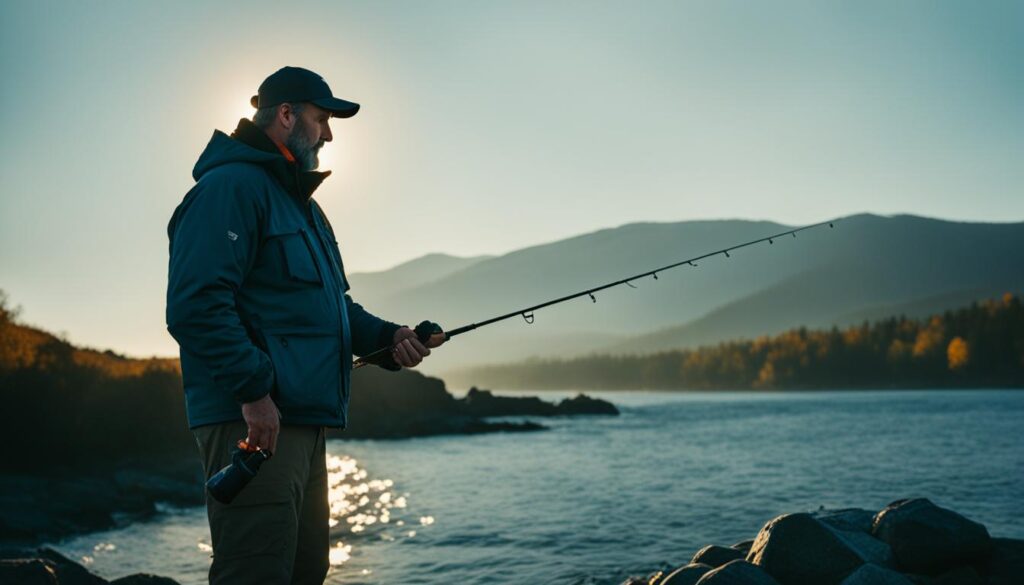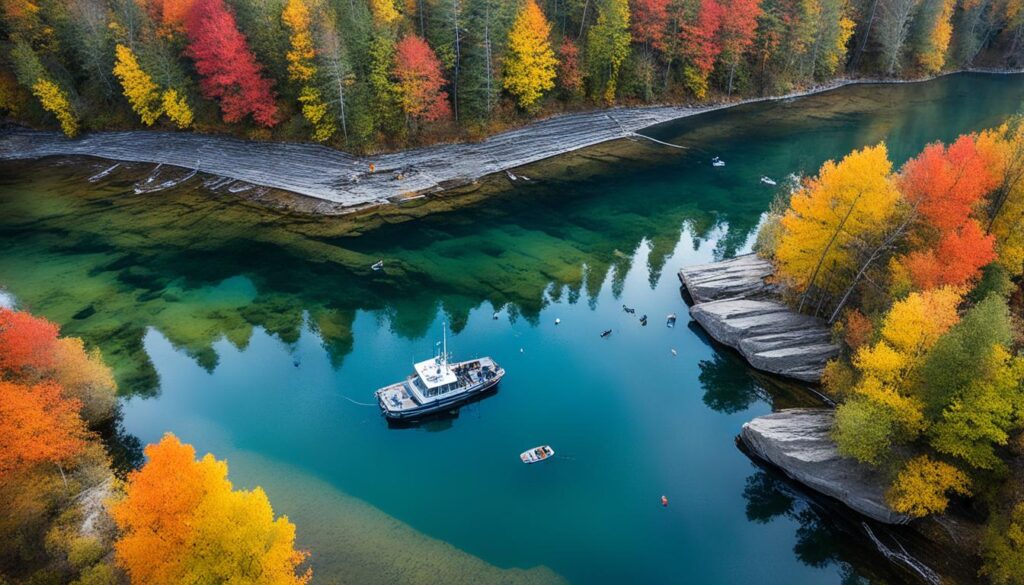As the days grow shorter and the water temperature begins to drop, many anglers shift their focus to fall bass fishing. While some may think that ledge fishing is primarily a summer pattern, it can actually be a highly effective technique well into the fall and early winter months. Ledges created by river and creek channels offer a drastic change in depth, providing perfect ambush points for bass to congregate and feed on baitfish.
Fall ledge fishing can be incredibly productive, but it’s important to understand the right conditions and strategies to maximize your success. In this article, I’ll share valuable insights on where to find fish, the advantages of fall ledge fishing, and tips for locating productive ledges. I’ll also cover the use of electronics, the importance of current, bait selection, fishing techniques, and regional considerations for ledge fishing.
Whether you’re a seasoned angler or new to bass fishing, these fall ledge fishing tips will help you target and land more quality fish. So, let’s dive in and discover the secrets to fall bass ledge fishing success!
Key Takeaways:
- Fall ledge fishing is a productive technique for catching bass well into the fall and early winter months.
- Ledges created by river and creek channels provide ambush points for bass to congregate and feed on baitfish.
- Understanding the right conditions and strategies is crucial for maximizing your success in fall ledge fishing.
- Topics covered in this article include advantages of fall ledge fishing, locating productive ledges, using electronics, the importance of current, bait selection, fishing techniques, and regional considerations.
- By implementing these tips and techniques, you can increase your chances of landing more quality fish during the fall bass fishing season.
Advantages of Fall Ledge Fishing
Fall ledge fishing offers several advantages that can maximize your fall bass fishing success. During this season, the fish are often more cooperative and willing to eat compared to the summer months. One of the main advantages is the presence of current on the ledges, which moves baitfish into balls and causes bass to group up tightly, feeding on the congregated bait. This behavior provides you with the opportunity to catch a lot of fish in a short amount of time.
Another advantage of fall ledge fishing is the lower fishing pressure. With the summer crowds gone, you can enjoy a more peaceful fishing experience and have more freedom to explore different areas without dealing with crowded fishing spots. This gives you a better chance of finding untouched ledges and increases your chances of success.
“Fall ledge fishing can be incredibly productive, with cooperative fish and fewer anglers competing for the same spots.”
By understanding the advantages of fall ledge fishing and utilizing the right techniques, lures, and strategies, you can maximize your success during this season and make the most of your fall bass fishing trips.
Locating Productive Ledges
When it comes to fall bass fishing, finding productive ledges is key to optimizing your success. These underwater structures serve as prime feeding grounds for bass, attracting them with the presence of current, bait, and a hard bottom. By understanding the characteristics that make a ledge productive, you can increase your chances of landing trophy bass.
First and foremost, current plays a crucial role in drawing schools of bass to feed on ledges. Look for areas with moving water, such as river and creek channels, as these are ideal locations for finding productive ledges. The natural flow of the current brings in baitfish, creating a feeding frenzy for bass.
To assist in your search, utilize electronic tools like side scan and live sonar. These cutting-edge technologies allow you to scan underwater and locate bait balls, as well as groups of fish tightly positioned on the ledge. By understanding the underwater topography and the movements of baitfish and bass, you can strategize your approach and increase your chances of success.
Additionally, pay attention to the presence of a hard bottom. Ledges formed by currents often have a rocky or gravelly substrate. These hard bottom areas attract crayfish and bluegill, which serve as essential food sources for bass. By focusing on ledges with a hard bottom, you can optimize your chances of finding concentrations of fish.

By considering the factors of current, bait, and hard bottom, you can effectively locate productive ledges during the fall bass fishing season. The combination of natural water flow, electronic tools, and understanding the feeding habits of bass will maximize your chances of landing a prized catch.
Using Electronics for Ledge Fishing
When it comes to fall bass fishing, using electronics can be one of the most effective tactics for maximizing your success. Technologies like side scan and live sonar provide valuable insights and help you locate productive areas on the ledges.
Side imaging allows you to identify groups of fish positioned on top of the ledge. By idling contour changes and graphing fish and bait on the ledges, you can quickly determine where the fish are congregating.
Live sonar, on the other hand, is useful for targeting both groups of fish located on the bottom and individual fish feeding on bait. It provides real-time feedback on the location and behavior of the fish, helping you make precise casts and presentations.
It’s important to note that timing is key when using electronics for ledge fishing. You’ll want to pay attention to the role of current in triggering fish to feed. When the current is strong and the conditions are right, the fish are more likely to be active and aggressively feeding on the ledges.
Overall, incorporating electronics into your fall bass fishing strategy can significantly increase your chances of success. By pinpointing the location of fish and bait, you can optimize your time on the water and make every cast count.
Importance of Current
One of the most effective tactics for fall bass fishing is understanding the importance of current. Current plays a crucial role in getting schools of bass to feed on ledges, making it a key factor in successful fall bass fishing methods. When there is moving water, fish are forced down onto the ledge, often congregating in one spot. This provides an excellent opportunity for anglers to target these concentrated groups of bass.
On the other hand, when there isn’t enough current, fish may roam off the ledges in search of bait, making it more challenging to locate and catch them. Therefore, paying attention to the presence of current is vital for optimizing your fall bass fishing success.
To effectively target bass on ledges, utilizing live sonar can be a game-changer. It allows you to precisely locate fish sitting on the ledge as well as those suspended in the water column. By utilizing this technology, you can determine the exact position of the bass and adjust your fishing techniques accordingly, increasing your chances of success.
Importance of Bait
While current is a significant factor in fall bass fishing, the presence of bait cannot be overlooked. Baitfish are a crucial food source for bass, and their presence can greatly influence the feeding behavior of these predatory fish. When there is a sufficient amount of bait around the ledge, it acts as a trigger, enticing bass to feed.
In order to effectively capitalize on the presence of bait, it’s important to choose suitable baits that mimic the forage in the area. Selecting lures that closely resemble the baitfish can increase your chances of attracting and enticing bass to bite. Experimenting with different colors and retrieval techniques can also play a significant role in triggering bass to strike.
Adjusting your approach based on the behavior of the fish and the availability of bait is crucial for successful fall bass fishing. By understanding the importance of current and the role of bait, you can optimize your tactics and increase your chances of a productive fishing trip.
Bait Selection for Fall Ledge Fishing
When it comes to fall bass fishing on ledges, there are a variety of baits that can help you maximize your success. While traditional options like jigs and crankbaits are still effective, there are a few other baits that can really shine as the water temperature drops.
Deep diving crankbaits are an excellent choice for catching quality fish when they are grouped up on the bottom. These lures mimic injured baitfish, and their ability to dive deep allows you to target bass that are holding tight to the ledge.
Jigs are another go-to bait for ledge fishing in the fall. They are especially effective for targeting individual fish that are sitting right on the ledge. By dragging a jig across the hard bottom, you can entice a reaction strike from these bass.
Damiki rigs provide a realistic alternative to crankbaits and are a great choice for targeting both suspended fish and those glued to the bottom. These rigs consist of a weight and a soft plastic bait, which can be rigged to imitate various types of forage. Damiki rigs excel at triggering bites from finicky bass on ledges.

Experimenting with different baits and adapting your techniques based on the behavior of the fish will be key to your success. By having a variety of options in your tackle box, you’ll be prepared to tackle any situation you encounter while fall ledge fishing.
Fishing Techniques for Fall Ledge Fishing
When it comes to fall bass fishing, using effective tactics and successful methods can make a big difference in your catch. Here are some tips and techniques to help you have a productive fall ledge fishing experience:
- Start your day with baits that target quantity-oriented predators. This will help you quickly locate fish and promising areas.
- Transition to larger baits like crankbaits or swimbaits once you locate a school of fish. These baits are effective at targeting big predators.
- Use crankbaits or spinnerbaits to attract bass around ledges. These lures can mimic the movement of baitfish and entice bass to strike.
- Consider using flutter spoons, rigs, and drop-shot rigs as productive alternatives. These baits can be effective in enticing bass feeding on or near the bottom.
- Allow your baits to sink to the ledge before starting your retrieve. This can help you target fish that are holding closer to the bottom.
- Start with a slow retrieve to imitate a wounded or injured baitfish. As you experiment, vary your retrieve speed to determine what triggers the best response from the bass.
- Position your boat away from the end of the ledge. This will allow you to keep your lure deeper in the water for a longer period of time.
| Bait | Target | Technique |
|---|---|---|
| Crankbaits | Bass around ledges | Retrieve the crankbait at different speeds to find the most effective presentation |
| Spinnerbaits | Bass around ledges | Slow roll the spinnerbait along the ledge, varying the retrieve speed and depth as needed |
| Flutter spoons | Bass feeding on or near the bottom | Let the spoon flutter down to the ledge and give it a subtle twitch or lift before retrieving |
| Rigs | Bass feeding on or near the bottom | Drag the rig along the ledge with occasional pauses to entice strikes |
| Drop-shot rigs | Bass feeding on or near the bottom | Fish the drop-shot rig vertically along the ledge, targeting suspended fish or those on the bottom |
By using these fishing techniques for fall ledge fishing, you can increase your chances of hooking into some quality bass. Remember to experiment with different bait presentations and be observant of the bass’ behavior to fine-tune your approach. Good luck!
Don’t miss a chance to land some big bass this fall!
Locating Schools of Bass on Ledges
To optimize your fall bass fishing on ledges, it’s essential to locate the schools of bass. By identifying the right areas, you can increase your chances of a successful fishing trip. Here are the best fall bass fishing strategies for finding schools of bass on ledges.
Look for Sloping Rock Banks
One effective strategy is to search for sloping rock banks that gradually descend into the water. These banks often have outcroppings at different depths, and the gentler-sloping areas can lead to ledges. Bass are known to position themselves along these ledges, taking advantage of the structure to ambush their prey.

Utilize Maps and High-Tech Equipment
To pinpoint the exact locations of ledges, you can leverage maps and high-tech equipment. Use your electronics to measure water depths, currents, and other relevant factors. Side scan and live sonar can be especially helpful in identifying potential hotspots. By analyzing the data and finding areas with the right characteristics, you can maximize your chances of locating schools of bass on ledges.
Fish Areas with Strong Currents
Strong currents play a crucial role in attracting and positioning bass on ledges. When there’s a good flow of water, it forces the fish to gather in specific spots, making them easier to target. Look for areas where strong currents are present, such as around river or creek channels. These zones often hold the highest concentration of bass on ledges.
Keep Moving if You Don’t Have Success
If you’re not finding bass in a specific area, it’s important to keep exploring. Some ledges may hold more fish than others, and certain currents may be more favorable for feeding activity. By moving to spots with stronger currents or different characteristics, you increase your chances of locating schools of bass on ledges. Be patient, adaptable, and persistent in your search for the best fishing opportunities.
| Best Fall Bass Fishing Strategies | Optimizing Fall Bass Fishing on Ledges |
|---|---|
| Look for sloping rock banks | Utilize maps and high-tech equipment |
| Fish areas with strong currents | Keep moving if you don’t have success |
By following these best fall bass fishing strategies and optimizing your approach for fishing on ledges, you’ll increase your chances of locating schools of bass and enjoying a successful fishing experience. Remember to adapt to the conditions, use technology to your advantage, and stay persistent in your search for productive spots.
Tips for Effective Ledge Fishing
When it comes to successful fall bass fishing, maximizing your fall bass fishing success depends on employing effective ledge fishing techniques. Here are some tips to help you make the most of your time on the water:
- Start with quantity-oriented baits: To quickly locate schools of bass, begin with baits that attract quantity-oriented predators. These include fast-moving lures like lipless crankbaits and swimbaits that cover a large area and trigger reaction strikes.
- Switch to larger baits: Once you locate a school, switch to larger baits that target bigger fish. Deep diving crankbaits and large jigs are excellent choices, as they can imitate the larger prey that bass are looking for during the fall months.
- Use a variety of techniques: Experiment with different retrieves to find what works best on a given day. Slow retrieves often work well for fall ledge fishing, as they allow the bait to stay in the strike zone longer. Try using a stop-and-go retrieve or occasionally pausing your bait to entice hesitant fish.
- Position your boat strategically: When fishing a ledge, position your boat away from the end of the ledge. This will help you keep your lure deeper in the water for a longer period, increasing your chances of enticing a strike from fish suspended in deeper waters.
- Experiment with colors: In deeper waters, warm color schemes tend to be more effective as they stand out better. Try using colors like red, orange, and chartreuse to catch the attention of bass lurking on the ledges.
- Be efficient in your fishing decisions: Spending time on the water and observing the behavior of the fish is crucial. Keep track of patterns and adjust your approach accordingly. If one technique isn’t producing results, don’t be afraid to experiment and switch things up to maximize your fall bass fishing success.
By following these tips and refining your ledge fishing skills, you’ll increase your chances of landing more bass during the fall season. Remember, the key to success is adapting to the changing conditions and being persistent in your pursuit of the big catch.
| Ledge Fishing Tips | Description |
|---|---|
| Start with quantity-oriented baits | Use fast-moving lures like lipless crankbaits and swimbaits to cover a large area and locate schools of bass. |
| Switch to larger baits | Target bigger fish with deep diving crankbaits and large jigs that imitate larger prey. |
| Use a variety of techniques | Experiment with different retrieves, including slow retrieves and stop-and-go techniques, to entice strikes. |
| Position your boat strategically | Stay away from the end of the ledge to keep your lure deeper in the water for a longer period. |
| Experiment with colors | Opt for warm color schemes like red, orange, and chartreuse to stand out in deeper waters. |
| Be efficient in your fishing decisions | Observe fish behavior, adjust your approach, and be persistent in your pursuit of success. |
Regional Considerations for Ledge Fishing
The effectiveness of ledge fishing can vary depending on the region you’re fishing in. Several factors, including water temperature, depth, and available baitfish, can influence the success of your ledge fishing techniques. It’s crucial to consider the specific characteristics of the body of water you’re fishing in and tailor your approach accordingly.
One way to gain valuable insights into local ledge fishing strategies is to research local tackle shops. They often have experienced staff who can provide expert advice on the top ledge fishing techniques specific to your region. Talking to local fishermen is also a great way to gather information. They can share their personal experiences, preferred colors, and bait choices that have worked well for them in the area.
Regional Tips:
- Research local tackle shops for expert advice on colors and bait choices.
- Talk to local fishermen to gain insights and learn from their experiences.
- Consider water temperature and adjust your fishing techniques accordingly.
- Take into account the depth of the body of water you’re fishing in.
- Stay informed about the available baitfish in your region.
Testimonial:
“I’ve been ledge fishing for years, and I’ve learned that each region has its own unique characteristics. Paying attention to those details and making adjustments to my approach has made all the difference in my success.” – Jake Thompson, experienced angler
By considering regional factors and gathering local knowledge, you can enhance your fall bass fishing experience and increase your chances of a successful outing. Tailoring your techniques to the specific conditions and understanding what works best in your region will ultimately lead to more productive and rewarding ledge fishing trips.
| Factors | Considerations |
|---|---|
| Water Temperature | Varying water temperatures affect fish behavior and feeding patterns. |
| Depth | Ledges come in different depths, and the fish may favor certain depths in your region. |
| Baitfish Availability | The type and availability of baitfish play a significant role in attracting bass to the ledges. |
| Local Techniques | Learning from local anglers and tackle shops can provide valuable insights into effective ledge fishing techniques. |
Conclusion
Fall ledge fishing is a highly productive technique for catching a large number of fish. To maximize your success, target ledges with current, bait, and hard bottom. Utilize electronics to locate productive areas, and adapt your bait and fishing techniques based on fish behavior.
Experimentation is key during fall ledge fishing. Spend time on the water, fine-tuning your approach, and be efficient in your fishing decisions. By exploring different colors, depths, and retrieve speeds, you can find what works best for the conditions and increase your chances of success.
Remember, successful fall bass fishing is all about maximizing your opportunities. Take advantage of the abundance of fish willing to feed during this time of year. With the right strategies and tactics, you can make the most of your fall ledge fishing experience and reel in some impressive bass.
FAQ
Where should I look for fish when fall ledge fishing?
Look for areas with current, bait, and hard bottom. Current is a major factor in getting schools of bass to feed on ledges, so finding areas with moving water is key. Hard bottom areas attract crayfish and bluegill, which are food sources for bass.
What are the advantages of fall ledge fishing?
Fall ledge fishing can be extremely productive as fish are more cooperative and willing to eat. The presence of current on the ledges moves baitfish into balls and causes bass to group up tightly feeding on the congregated bait. Fishing pressure tends to be lower in the fall, making it easier to avoid crowded fishing areas.
How can I locate productive ledges?
Use electronics such as side scan and live sonar to locate bait balls and groups of fish holding tight to the ledge. Look for areas with current, bait, and hard bottom. Sloping rock banks that descend into the water and areas with strong currents are also promising spots to find bass on ledges.
How can I use electronics for ledge fishing?
Side scan and live sonar are extremely useful tools for ledge fishing. Side imaging can identify groups of fish positioned on top of the ledge, while live sonar can be used to target fish on the bottom and those feeding on bait. These technologies allow you to quickly locate productive areas and graph fish and bait on the ledges.
Why is current important for ledge fishing?
Current is crucial in getting schools of bass to feed on ledges. Moving water forces fish down onto the ledge, often congregating them in one spot. When there isn’t current, fish may roam off the ledges in search of bait, making the fishing tougher.
What baits should I use for fall ledge fishing?
Traditional ledge fishing baits such as jigs and crankbaits still work in the fall. Deep diving crankbaits are great for catching quality fish when they are grouped up on the bottom, while jigs are effective for targeting individual fish sitting right on the ledge. Damiki rigs are a great choice for targeting both suspended fish and those glued to the bottom.
What fishing techniques should I use for fall ledge fishing?
Start your day with baits that go for quantity-oriented predators to quickly find fish and promising areas. Transition to larger baits like crankbaits or swimbaits to target big predators once you locate a school. Experiment with different retrieves and positioning your boat away from the end of the ledge to keep the lure deep in the water for the longest period of time.
How can I locate schools of bass on ledges?
Look for sloping rock banks that descend into the water. These banks will have outcroppings at different depths, and gentler-sloping banks will lead to ledges. Use maps, high-tech equipment, or fish areas with sloping banks and strong currents to measure water depths and currents.
What tips can you provide for effective ledge fishing?
Spend time on the water and be efficient in your fishing decisions. Experiment with different baits, colors, and techniques. Pay attention to the behavior of the fish and adapt your approach accordingly. Research local tackle shops and talk to local fishermen for valuable insights on colors and bait choices that work well in your specific area.
Are there regional considerations for ledge fishing?
Yes, the effectiveness of ledge fishing can vary by region. Factors such as water temperature, depth, and available baitfish can influence the success of ledge fishing techniques. It’s important to consider the specific characteristics of the body of water you’re fishing in and tailor your approach accordingly.
